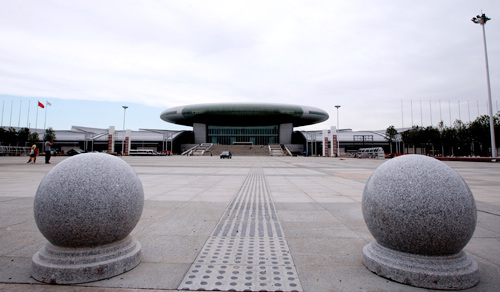|
 |
|
EXPO VENUE: The newly constructed International Exhibition Center in Urumqi, Xinjiang Uygur Autonomous Region, will host the China-Eurasia Expo in September (JIANG XIAOYING) |
As early as 2,200 years ago, Xinjiang was known as an important part of the Silk Road, the vital trade route that connected China with Central Asian, West Asian and even Mediterranean nations. Even today its natural location gives Xinjiang an insuperable advantage in terms of trade with Eurasian states. In 2010 China decided to hold the China-Eurasia Expo annually in Xinjiang's capital Urumqi as part of a strategy to accelerate the region's development. The first expo will be held between September 1 and 5 this year.
According to Chen Ji, Deputy Director of the Xinjiang-Eurasia Expo Secretariat, the event will replace the former Urumqi Foreign Economic Relations and Trade Fair. "In some ways it's an upgrade but the China-Eurasia Expo is not just a trade fair," Chen said.
Chen said the new expo would be a platform for diplomacy between China and the Eurasian states and a channel that promotes Xinjiang's cooperation with China's neighboring countries particularly Russia, Kazakhstan, Kyrgyzstan, Tajikistan, Pakistan, India, Afghanistan and Mongolia. Xinjiang has 29 ports for trade with these countries.
Xinjiang's increasingly modern infrastructure allows it to serve as a gateway to the world. The Eurasian Land Bridge threads its way through Xinjiang. The 10,837 km rail route starts from Lianyungang Port in east China's Jiangsu Province, passes through Xinjiang and ends at Rotterdam Port in the Netherlands.
Xinjiang officials hope events like the China-Eurasia Expo will allow Xinjiang to capitalize on its status as a bridge between China and Eurasia. They believe the region's increasing accessibility will allow it to attract more investment from home and abroad, which will help narrow the development gap between Xinjiang and central and eastern regions of China.
"It is part of the country's opening-up strategy, which includes the opening up of coast areas, the opening up of border areas and the opening up of the western regions," Chen said.
The expo is co-organized by 29 Central Government departments including the Ministry of Commerce and Ministry of Foreign Affairs, co-hosted by 22 provinces and municipalities, and co-sponsored by 11 governmental agencies of Xinjiang.
"Along with the expo, August 31 to September 2 will see 1+8 forums and other theme activities," Chen said.
The event's principal forum is the China-Eurasia Forum on Economic Development and Cooperation, which will be attended by top Chinese leaders, dignitaries from foreign countries and representatives from international organizations. The remaining "eight" events include six minister-level forums concerning trade, tourism, agriculture, banking, technological cooperation and the media, a development forum between overseas Chinese business people and Xinjiang Government departments, and a weeklong cultural exhibition.
The expo will be held in Urumqi's newly constructed International Exhibition Center, which has 45,000 square meters indoor and 37,000 square meters outdoor. The whole exhibition area will be divided into six parts with different themes. As of late June, at least 20 Eurasian nations including Kazakhstan, Russia, Malaysia, Pakistan, Iran, Germany and Switzerland had confirmed their participation in the expo.
In addition to government departments, more than 2,200 businesses, both local and international, had also applied to participate in the expo by late June. The whole exhibition center is expected to have 2,000 standard exhibiting booths. "This is beyond our expectation. There will be more applicants coming, so we are preparing to expand the outdoor exhibition area to hold more people," Chen told Beijing Review.
He said there would be several test exhibitions in the center in July, in order to guarantee the success of the China-Eurasia Expo.
"We are very confident the expo will be more successful than the former Urumqi trade fair. It will attract more businessmen and investors," Chen said.
The Urumqi trade fair was held every year between 1992 and 2010. Statistics from the autonomous regional government show, during the past 19 years, the trade fair attracted more than 10,000 Chinese enterprises and business people from over 70 countries and regions to participate. The volume of foreign trade contracts signed during its tenure totaled $39.65 billion, while the volume of domestic trade contracts amounted to 158.506 billion yuan ($24.39 billion).
Nur Bekri, Chairman of the Xinjiang Regional Government, said, "The Urumqi trade fair has accomplished its historical mission, and the China-Eurasia Expo will play a bigger role in boosting Xinjiang's opening up." | 